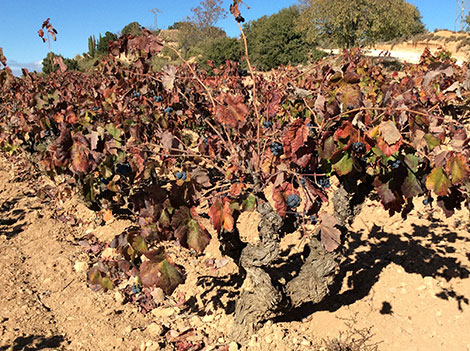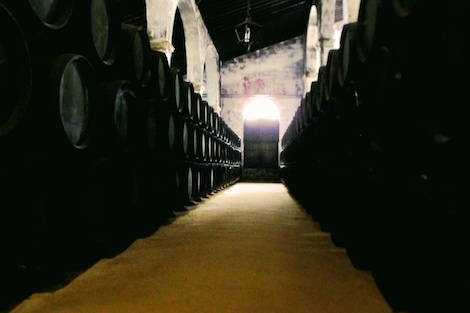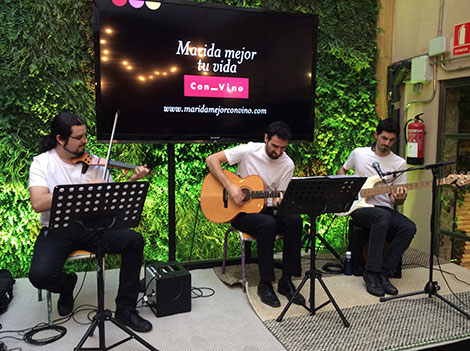
Before the turn of this century, Bobal was recognised as a source of vibrant, fresh rosé wines. Over the past decade, producers have tried to prove that this variety is also capable of producing high quality reds but Bobal’s trademark rusticity and unwieldy tannins have not made it easy.
ConBobal, a conference organized by DO Manchuela in Albacete on November 10th, helped to dispel some misconceptions about this variety, widely grown in southeast Spain. Bobal's strongest point was also revealed: its almost perfect pH levels that make it particularly suitable to produce long-lasting reds, rosés that retain freshness for longer than the average and –this is the great news– sparkling wines.
Ten things to know about Bobal
1. It has been widely overlooked. Despite being Spain’s third most widely grown variety only behind Airén and Tempranillo (both of which exceed 200,000Ha), Bobal remains largely unknown. A fantastic source of colour and body, it has been traditionally used for bulk wine.
2. A homely variety. Most of the 67,000 Ha of Bobal are concentrated in Spain’s southeast, in the provinces of Cuenca, Albacete and Valencia under the Manchuela, Ribera del Júcar and Utiel-Requena appellations. The presence of Bobal plants in Aragón, La Rioja, other wine regions in Castilla-La Mancha and Ribera del Duero suggests that this variety occupied a greater area in the past but it is the one of the few Mediterranean grapes that wasn’t planted abroad – although it is believed that Australians may be interested in it. Under these circumstances, Spanish expert Gregorio Muñoz, head of research at IMIDRA, suggests it should be classified as a minority crop.
3. Unknown parents. According to Muñoz, Bobal is an ancient variety with a long track record of synonyms and constantly linked to Mediterranean areas in Spain. Its ancestors remain unknown and could well be extinct, but it is likely that one of them was a table grape variety, a fact that would explain the large size of both its bunch and berries. Bobal is related to ancient varieties grown in the south like Teta de Vaca, Cojonata and Palote, as well as Señá and Heben in central and northern areas in Spain. The closest relative found so far is a Calzariza, a new genotype discovered in Cifuentes (Guadalajara, in Castilla-La Mancha) which is thought to be an offspring.
4. Living the high life. Found at 600 to 1,100 metres above sea level, Bobal thrives on cold and dry inland Mediterranean areas with sharp temperature variations between day and night. Such conditions are ideal to have healthy, well-ventilated grapes which are particularly suitable for organic certification.
5. A prized attribute. High pH* levels are linked to climate change and are one of the major challenges faced by wine producers worldwide. Bobal stands out from the crowd with pH levels ranging from 3.35 to 3.50. “It is so well balanced that no adjustments are needed in the winemaking process”, says Toni Sarrión from Bodegas Mustiguillo, one of the top producers working with Bobal. At the ConBobal conference, Italian winemaker Andrea Boaretti, who consults for Bodegas Iniesta (Manchuela) in the production of sparkling wines following the Charmat method, confessed that he is fascinated by this attribute, a key factor when it comes to fizz.
6. An unlikely catch. In addition to its excellent acidity, Bobal is particularly resistant to drought (another advantage in the face of climate change) and oidium. It produces deeply coloured reds (hence its success in bulk wines) and fits in the healthy trends thanks to its high antioxidant content. And as Toni Sarrión remarked, “it is an indigenous grape and very much our own.”
7. Its flaws can be fixed. Bobal’s two main shortcomings are its high yields and its large and compact bunches, probably derived from its table grape ancestor. Bunch ripening is uneven and berries in the inner area often remain green. This explains Bobal’s rusticity and harsh tannins found in many red wines made with it. In his presentation, Sarrión explained that he had managed to grow looser, smaller bunches (see the process in the photo above) by reducing vigor with ground-cover vegetation and intense pruning work in the winter and summer. The need to have Bobal clones with loose bunches emerged at various stages of the conference.
8. Bubbly Bobal. Italian winemaker Andrea Boaretti explained that many of the flaws associated with Bobal actually turn into virtues when it comes to making Prosecco-style sparkling rosés. “The ideal requirements are fertile soils, high yields, a generous canopy to protect bunches from the sun and fresh exposures. Acidity and little colour are key elements here, so we don’t need fully ripe bunches”, he explained. Cold mornings and the absence of humidity are additional advantages to conduct cold macerations, said Boaretti, who called for sparkling wines to be accepted by the DO Manchuela.
9. Rosé at its best. A majority of conference speakers agreed on the unique character of Bobal rosés, which was also Boaretti’s favorite style when he discovered Bobal. With a vivid colour and violet reflections, rosés are notably lively and vibrant and their low pH keeps them in great shape until the new vintage is released. Most of the 2016 rosés I had the chance to taste during the seminar did not feel flabby.
10. The harsh truth. Wine educator and expert Juancho Asenjo conducted a tasting of red Bobal wines from Manchuela, Ribera del Júcar, Utiel-Requena and Vino de Pago Finca El Terrerazo. None of the wines showed harsh or unbalanced tannins. Oak was present in some of the samples; others showed firm palates that will take some time to smooth and I also found some earthy, slightly rustic edges, but in all cases these notes added character and a sense of place.
Six wines to discover Bobal
Corazón Spumante Rosé, Bodegas Andrés Iniesta (Table Wine). A sparkling wine made from Bobal. Made with the Charmat method (like Prosecco), it has 12g/l of residual sugar and 20% of wine comes from a previous vintage. Pale colour; fresh nose with aniseed and petal aromas. A crowd-pleaser: the slightly sweet palate is balanced with Bobal’s vibrant acidity making it very easy to drink.
Find this wine for €6.50 at the winery’s online store or via Wine Searcher.
Cueva Llana 2016 Rosé, Señorío del Júcar (Manchuela). A newcomer to the area, this producer’s wines display cutting edge labels when compared with the standard in the region. With zesty acidity, this Cueva Llana 2016 is a perfect example of the ability of Bobal rosés to retain freshness.
Find this wine for 10,90 € at Señorío del Júcar or Bodega Willy (Mercado Barceló, Madrid)
Rayuelo 2013 Red, Altolandon (Manchuela). You are unlikely to find any other Bobal grapes grown at such high altitude in Spain. Standing at 1,100m above sea level in the village of Landete (Cuenca), the vines sink their roots on poor, sandy-loam and gravely soils. Deep, vivid purple colour. Fresh, fragrant nose with wild herbs, red fruits, spices and ligneous nuances. Light bodied but with supple texture and fine tannins and retaining Bobal’s earthy character. Great value.
Find this wine for €9 at the winery’s website.
L’Alegría Cepas Viejas sobre Arcilla 2015 Red, Bruno Murciano (Utiel-Requena). A different style of Bobal, full but gentle, grown on clay soils. The wine spends three months in concrete tanks then six months in 500-litre used barrels. Crisp, well-defined red fruit preserve with a touch of chalk and fresh herbal aromas. Full, unctuous palate with good balance and freshness. It is worth getting hold of some of the 11,500 bottles that have been produced.
Find this wine for €12.50 at Bodeboca.
PF 2016 Tinto, Bodegas y Viñedos Ponce (Manchuela). Grapes are sourced from an ungrafted (pie franco) vineyard grown on sandy soils. The winemaking style is based on whole bunch fermentation, malolactic with thick lees and the use of large barrels or foudres for aging. Lovely fruit expression (maceration, cherries, liquorice), broad palate and firm but fine tannins. A mouthwatering red with a brinyish finish that will appeal to terroir-driven aficionados as will Ponce’s two other single vineyard wines: the sapid, elegant, restrained Estrecha and the aerial and vibrant Pino.
Find this wine for €14.40 at Gourmet Hunters.
Finca El Terrerazo 2012 Tinto, Bodegas Mustiguillo (Vino de Pago El Terrerazo). Regarded as the first premium Bobal, grapes are sourced from the eponymous property located in Utiel (Valencia). The estate has its own single-vineyard category (Vino de Pago in Spain). Deep, bright colour. Fine woodland aromas followed by dried herbs, red and black fruit and creamy notes from the oak. This is a serious and well-defined red with fine tannins and a long finish with liquorice and briny notes.
Find this wine for €24.20 at Ideavinos or via Wine Searcher.
* Closely linked to acidity, pH is an indicative of ripeness, colour, flavour and the ability to age. pH in wine usually ranges from 2.9 to 4.2, but high quality reds should avoid pH levels above 3.8 to ensure they remain stable and have the ability to age.

Amaya Cervera
A wine journalist with almost 30 years' experience, she is the founder of the award-winning Spanish Wine Lover website. In 2023, she won the National Gastronomy Award for Gastronomic Communication
NEWSLETTER
Join our community of Spanish wine lovers






